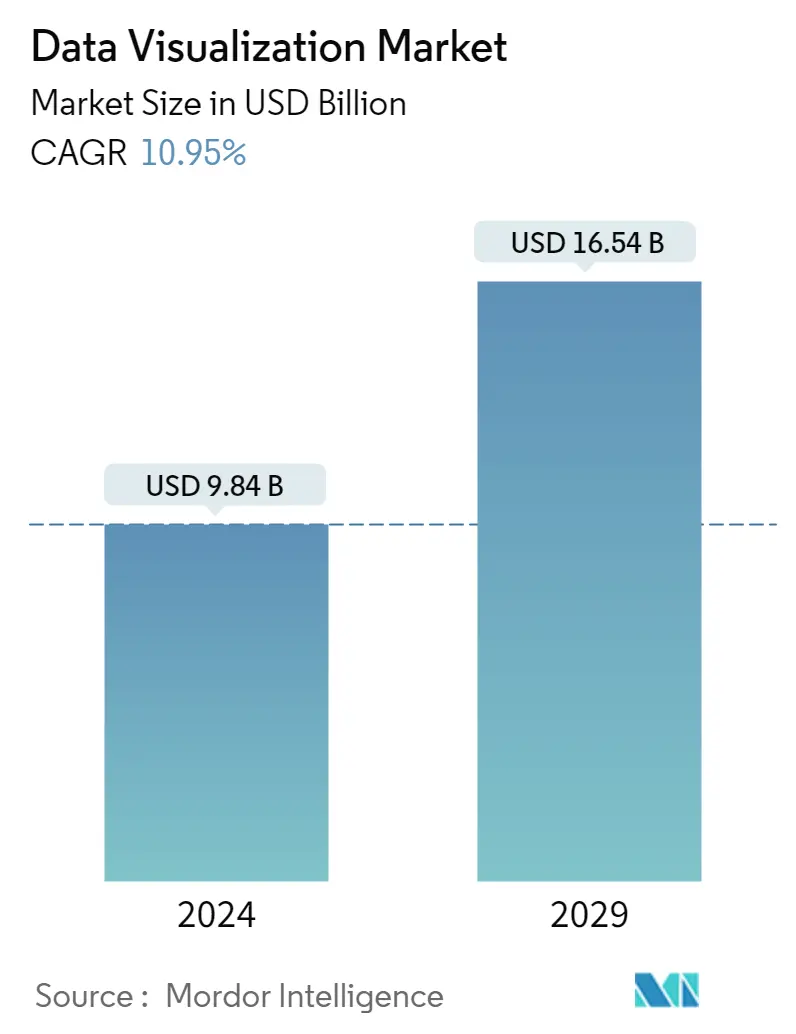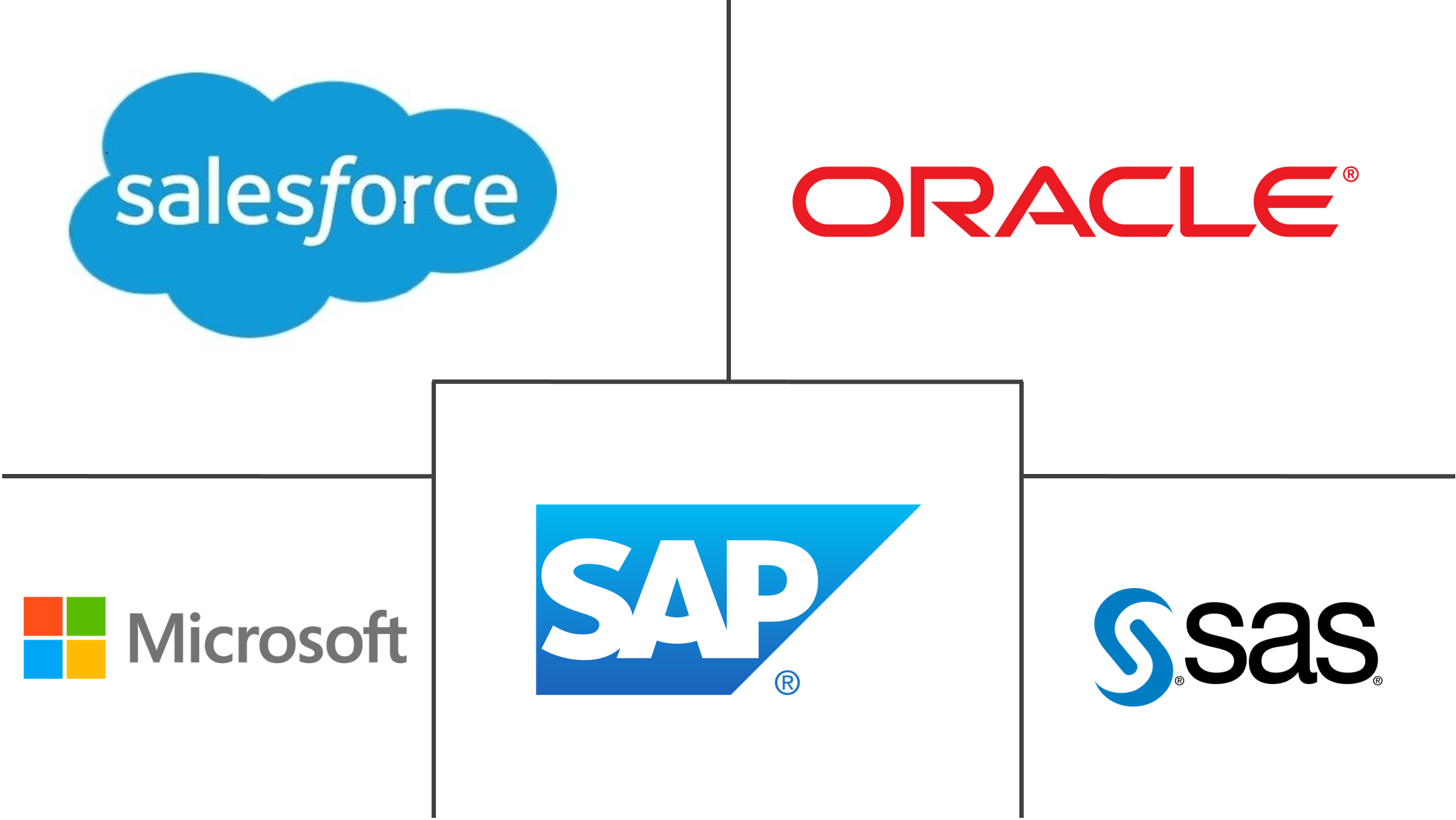Market Size of Data Visualization Industry

| Study Period | 2019 - 2029 |
| Market Size (2024) | USD 9.84 Billion |
| Market Size (2029) | USD 16.54 Billion |
| CAGR (2024 - 2029) | 10.95 % |
| Fastest Growing Market | Asia Pacific |
| Largest Market | North America |
Major Players
*Disclaimer: Major Players sorted in no particular order |
Data Visualization Market Analysis
The Data Visualization Market size is estimated at USD 9.84 billion in 2024, and is expected to reach USD 16.54 billion by 2029, growing at a CAGR of 10.95% during the forecast period (2024-2029).
The emerging nature of data visualization encourages a shift toward analytically driven businesses, where users can explore data in various forms of graphical representation, initially only available in tabular reports.
- Across many industries, businesses are realizing the benefits of data-driven decision-making. Extracting useful information from big, complicated databases is becoming increasingly important. Data visualization is essential for demystifying complex information and presenting it in a visually appealing manner that is simple to comprehend and analyze. As companies look for ways to extract valuable insights from their data, inference implies that the market for data visualization tools will keep growing. Decision-makers may find patterns, trends, and correlations by efficiently visualizing data, which helps them make more well-informed strategic decisions.
- The term "augmented reality" refers to a technology that overlays digital data, such as visualizations, on the physical environment. A new development that has the potential to change the market completely is the incorporation of AR with data visualization tools. AR can give consumers an immersive and engaging experience that enables them to explore and analyze data in novel ways by superimposing data visualizations onto real-world objects or environments. This technology can be used in several fields, including manufacturing, healthcare, and retail, where real-time data visualization in a geographical context can improve judgment, training, and consumer interaction.
- The combination of natural language processing and conversational interfaces is another distinctive market driver for data visualization. NLP enables computers to comprehend, translate, and produce human language, allowing users to communicate with data visualization tools using natural language instructions or queries. Through dialogues with the system, users can ask questions, request certain visualizations, or examine data by utilizing NLP. Due to its lower learning curve than conventional graphical user interfaces, this driver may make data visualization more approachable to a wider audience. Additionally, it creates possibilities for data-driven decision-making via voice-enabled gadgets like smart speakers and virtual assistants.
- Data privacy and security have become major concerns as the volume of data being generated and analyzed continues to increase. Inference suggests that organizations and individuals are becoming more aware of the potential risks associated with data breaches and unauthorized access to sensitive information. This heightened awareness has led to stricter regulations, such as the General Data Protection Regulation (GDPR) in the European Union and the California Consumer Privacy Act (CCPA) in the United States. These regulations impose limitations on how organizations collect, store, and process personal data.
- COVID-19 brought about unprecedented challenges, requiring organizations to focus on crisis management and business continuity. Data visualization played a vital role in helping businesses monitor key metrics, identify potential risks, and develop strategies to mitigate the impact of the pandemic. Visualizations enabled organizations to track supply chain disruptions, analyze customer behavior shifts, and monitor the financial health of their businesses. By visualizing these critical insights, organizations could respond more effectively to the crisis and adapt their operations to ensure business continuity. There has also been an impact of the Russia-Ukraine war on the overall packaging ecosystem.
Data Visualization Industry Segmentation
Data visualization represents a wide range of business applications. Visualizing data is a concept used in different terms and technologies, including dashboards, infographics, scorecards, analytics, big data, and business intelligence. Data Visualization helps extract a meaningful report from the diverse and rapidly increasing volumes of business data. Many users believe that using big data for data visualization helps better decision-making.
The data visualization market is segmented into by organization department (executive management, marketing, operations, finance, sales), deployment mode (on-premise, cloud/on-demand), end user (BFSI, IT and telecommunication, education, manufacturing, government, retail/e-commerce) and geography (North America, Europe, Asia-Pacific, Latin America, and Middle East & Africa). The report offers market forecasts and size in value (USD) for all the above segments.
| Organizational Department | |
| Executive Management | |
| Marketing | |
| Operations | |
| Finance | |
| Sales | |
| Other Organizational Departments |
| Deployment Mode | |
| On-premise | |
| Cloud/On-demand |
| End User | |
| BFSI | |
| IT and Telecommunication | |
| Retail/E-commerce | |
| Education | |
| Manufacturing | |
| Government | |
| Other End Users |
| Geography | |
| North America | |
| Europe | |
| Asia-Pacific | |
| Latin America | |
| Middle East and Africa |
Data Visualization Market Size Summary
The data visualization market is experiencing significant growth as businesses increasingly recognize the importance of data-driven decision-making. This market is evolving rapidly, driven by the need to transform complex data into visually comprehensible formats that facilitate analysis and insight generation. The integration of advanced technologies such as augmented reality and natural language processing is further propelling the market forward, offering users innovative ways to interact with and interpret data. These technologies enhance user engagement and accessibility, making data visualization tools more approachable for a broader audience. As organizations strive to harness the power of big data, the demand for effective data visualization solutions continues to rise, supporting strategic decision-making across various sectors.
North America stands out as a key region in the data visualization market, fueled by the adoption of advanced technologies and a strong presence of vendors. The United States, in particular, is witnessing robust growth due to the increasing volume of data generated by businesses. The market is moderately competitive, with major players like Salesforce, Microsoft, and Oracle actively innovating to expand their market share. Recent strategic partnerships and acquisitions, such as Tempo Software's acquisition of Amovos SRO and Microsoft's collaboration with Grafana Labs, highlight the ongoing efforts to enhance data visualization capabilities. These developments, along with the growing need for data-driven insights in sectors like retail and manufacturing, are expected to drive the market's expansion in the coming years.
Data Visualization Market Size - Table of Contents
-
1. MARKET DYNAMICS
-
1.1 Market Overview
-
1.2 Industry Attractiveness - Porter's Five Forces Analysis
-
1.2.1 Threat of New Entrants
-
1.2.2 Bargaining Power of Buyers/Consumers
-
1.2.3 Bargaining Power of Suppliers
-
1.2.4 Threat of Substitute Products
-
1.2.5 Intensity of Competitive Rivalry
-
-
1.3 Value Chain Analysis
-
1.4 Introduction to Market Drivers and Restraints
-
1.5 Market Drivers
-
1.5.1 Cloud Deployment of Data Visualization Solutions
-
1.5.2 Increasing Need for Quick Decision Making
-
-
1.6 Market Restraints
-
1.6.1 Lack of Tech Savvy and Skilled Workforce/Inability
-
-
-
2. MARKET SEGMENTATION
-
2.1 Organizational Department
-
2.1.1 Executive Management
-
2.1.2 Marketing
-
2.1.3 Operations
-
2.1.4 Finance
-
2.1.5 Sales
-
2.1.6 Other Organizational Departments
-
-
2.2 Deployment Mode
-
2.2.1 On-premise
-
2.2.2 Cloud/On-demand
-
-
2.3 End User
-
2.3.1 BFSI
-
2.3.2 IT and Telecommunication
-
2.3.3 Retail/E-commerce
-
2.3.4 Education
-
2.3.5 Manufacturing
-
2.3.6 Government
-
2.3.7 Other End Users
-
-
2.4 Geography
-
2.4.1 North America
-
2.4.2 Europe
-
2.4.3 Asia-Pacific
-
2.4.4 Latin America
-
2.4.5 Middle East and Africa
-
-
Data Visualization Market Size FAQs
How big is the Data Visualization Market?
The Data Visualization Market size is expected to reach USD 9.84 billion in 2024 and grow at a CAGR of 10.95% to reach USD 16.54 billion by 2029.
What is the current Data Visualization Market size?
In 2024, the Data Visualization Market size is expected to reach USD 9.84 billion.

